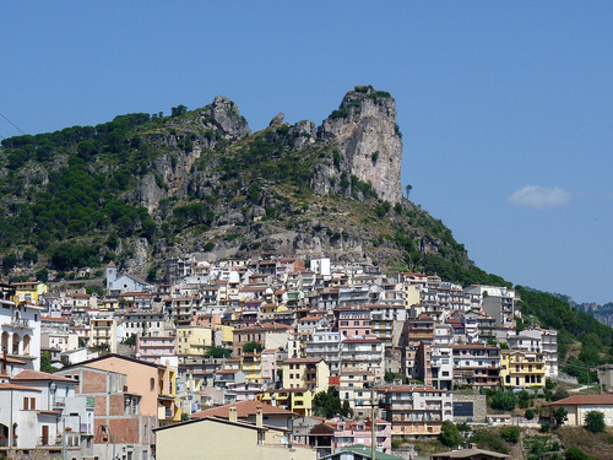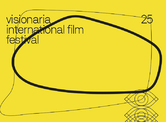Ulassai, in Ogliastra, is a place where fantasy is at home. It lives in the air that it breathes and the water it drinks, so the guests and inhabitants of Ulassai are never surprised at anything, not even at hearing a group of palm trees passing by that way.
Ulassa, a village in Sardinia in the Province of Lanusei, belonging to the Jerzu district, under the jurisdiction of the court of first knowledge of the abovementioned capital, and in the department of the eastern Barbagia, then called Giudicato of the Ogliastra, pertaining to the ancient reign of Plumino, or Cagliari… It lies at the eastern slope of the long Tisillo mountain range, where Jerzu and Osini are equally situated.
The palms are not only trees, they are also lady artists, strollers, feminists. Someone, down at the Tortolì sea, left this world before her time, struck down by the red palm weevil, the frightful Rhynchophorus Ferrugineus that plagues and kills them. Ulàssai d’Ogliastra, tall and hovering, resembles Constantin Brancusi’s Maiastra. Costantino known as Antine, like Nivola, he’s at home here too.
In the mountains you can find wild boars and deer, and you can also meet some mouflon; but there aren’t many of them, so that some hunters come back with no prey. The great vegetation is mostly species of oak, and the forest is rather populated, it has suffered few spoils thus far. The chalky rock dominates, and the natural cavern called Sa Grutta de su marmuri is worth noting, where one can observe many of those concentrations which they call stelattiti and stelagmiti.
“Ulàssai Station” announces the stationmaster with a stentorian voice. Station of Art. End of the line. Train conductor. Long whistle. The train is hidden in Su Marmuri grotto. End of the ride for those beautiful cars from the 1950’s. Ulàssai: altitude 775 meters from sea level and from Maria Lai, down there in Cardedu.
Eco di Marosini. On the road to Osini and just a kilometre from Ulassa, in the middle of the road, a triangular stone is seen, whose smallest side approximately .75 meters, in which the fire of an echo is found, which marvels passersby. The villagers explain the name that fantastic stories have been told about, that a certain Maria di Osini, who climbed up on the rock, which had a deep hollow, and stayed against the stated point the distance of a musket shot, having dropped the gun stock in the aperture while she strained to get it back, she fell, and from her spirit words were repeated, that uttered the people located on the abovementioned rock.
In Cardedu, down at the sea, there’s Maria palm Lai among orange trees, carobs, pomegranate, cedar sultanas, baobob, breadnut and fontane di Nivola. Her personal anxiety of the infinite regenerates the land and sews up the crevices. Maria Lai was invented by a distracted god because he couldn’t be everywhere and think about everything. Look, there’s a palm in the station: it comes from Tortolì, from Su logu de s’iscultura, the sculpture garden. There are two more: one is Paloma, the other is Palmira, they come from Cagliari, from the courtyard of the ex-Tobacco Factory, and they always smoke, even where it’s prohibited. They are labour palms, old retired cigar rollers, but this doesn’t stop them from climbing on the roofs of the factories, the university buildings, the train stations. Here’s an entire posse of palm-friends. They come from the spa of a resort in Arbatax, but thalassotherapy and massages won’t heal them from the red palm weevil. And here they are all together to celebrate with cocoi prenas and culurgiones (stuffed bread and pasta).
The ordinary quantity of annual sowing is calculated as 800 starelli of grain, 400 of barley, 100 of fava beans...In some places linseed was planted, such that what is needed by the respective families is obtained… The grape harvest gives approximately 200 carratelli. The surplus of the consumption is transported to Tortolì to sell it to the Genoese and the others that frequent that port…The wine is valued for its good quality like that of Jerzu and the other towns in Ogliastra. The arboriculture is extensive, and one may calculate more than 15 thousand stumps in the different species cultivated on the island. The most common are cherries, pears, nuts, walnuts, chestnuts, almonds, olives.
The palms fly. Mario Schifano proved it. They fly along with donkeys, hippogriffs and kites. The palms get dressed up when they get the chance. The palms use high heels and go on the heels of Ulàssi. They are the only ones who manage to do it, dancing and singing glibly, and everyone can ask them to dance. They toast to everyone’s health and to the memory of every dead or dying palm, and there are already lots of them. The palms die inside the cemeteries, in the flower beds of the hospitals, on the seafront, in the gardens of the ex psychiatric hospitals. Way of the Cross for Palms, station after station. Last stop Art.
The service livestock consists of approximately 350 oxen for ploughing and hauling, horses for loading goods and some for riding, 120 mares. The rough livestock has the following particular numbers in its usual species: 1200 cows, 150 horses, 6000 goats, 4000 sheep, 1000 pigs.
A story that ends badly for the palms. They say that a palm out of the swing of things must have been sawed down, chopped up and incinerated to avoid the disease spreading even from her poor remains. “Let’s not think about it – says Paloma Palm – we’re here to celebrate”. She made it to where not even the goats manage to climb. With her Palmira Palm, so tall you could see her from Asinara to Pula. In the park of the city of Nora, Phoenician, Punic, Roman, Christian, Byzantine, Judicial, Catalan-Aragonese, Savoy, Risorgimento, and Partisan palms die. “We have to invent something - says Palmira – something that can leave the mark of the passing of us palms in this landscape”. Going back down towards the town holding hands, headed for the Station of Art, Palmira gets the idea: depict the embrace of a healthy and sturdy palm and one weakened by the red palm weevil, one florid and seductive, the other lifeless and drooping. There they are, in sight of the Station of Art. They stop along the way and kiss for a long time. The Ulasessis cheer. They had never seen such a passionate kiss, between two palms. Everyone kisses each other enthusiastically like they never had before. But this isn’t written anywhere to be found in the Angius-Casalis.
When the provincial road to Ogliastra will be laid, which they’re already working on, the Ulassesis will be able to join it with little expense along the line that will be laid from Jerzu, and that will connect Osini and Gàiro as well.
Note. The passages in italics are taken from: Dizionario Geografico-Storico-Statistico-Commerciale degli Stati di S.M. il Re di Sardegna, by Vittorio Angius and Goffedro Casalis, Torino, 1833-1856.
links:









